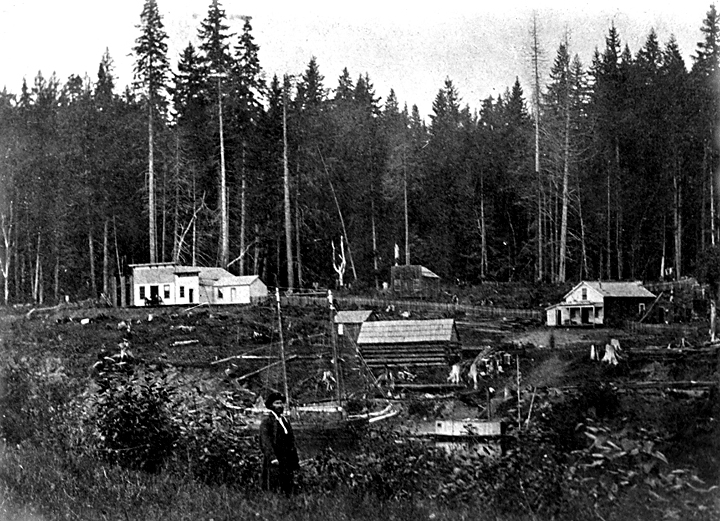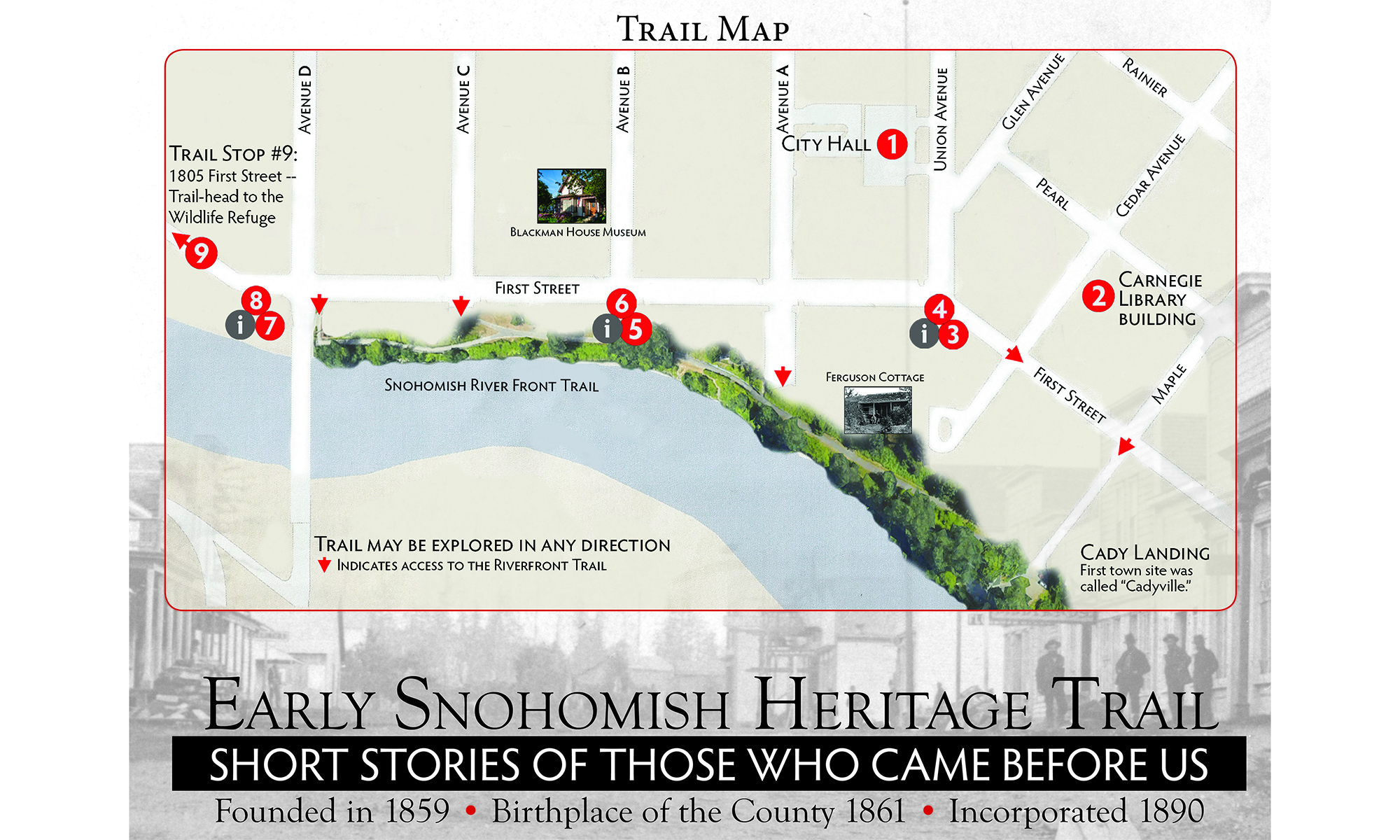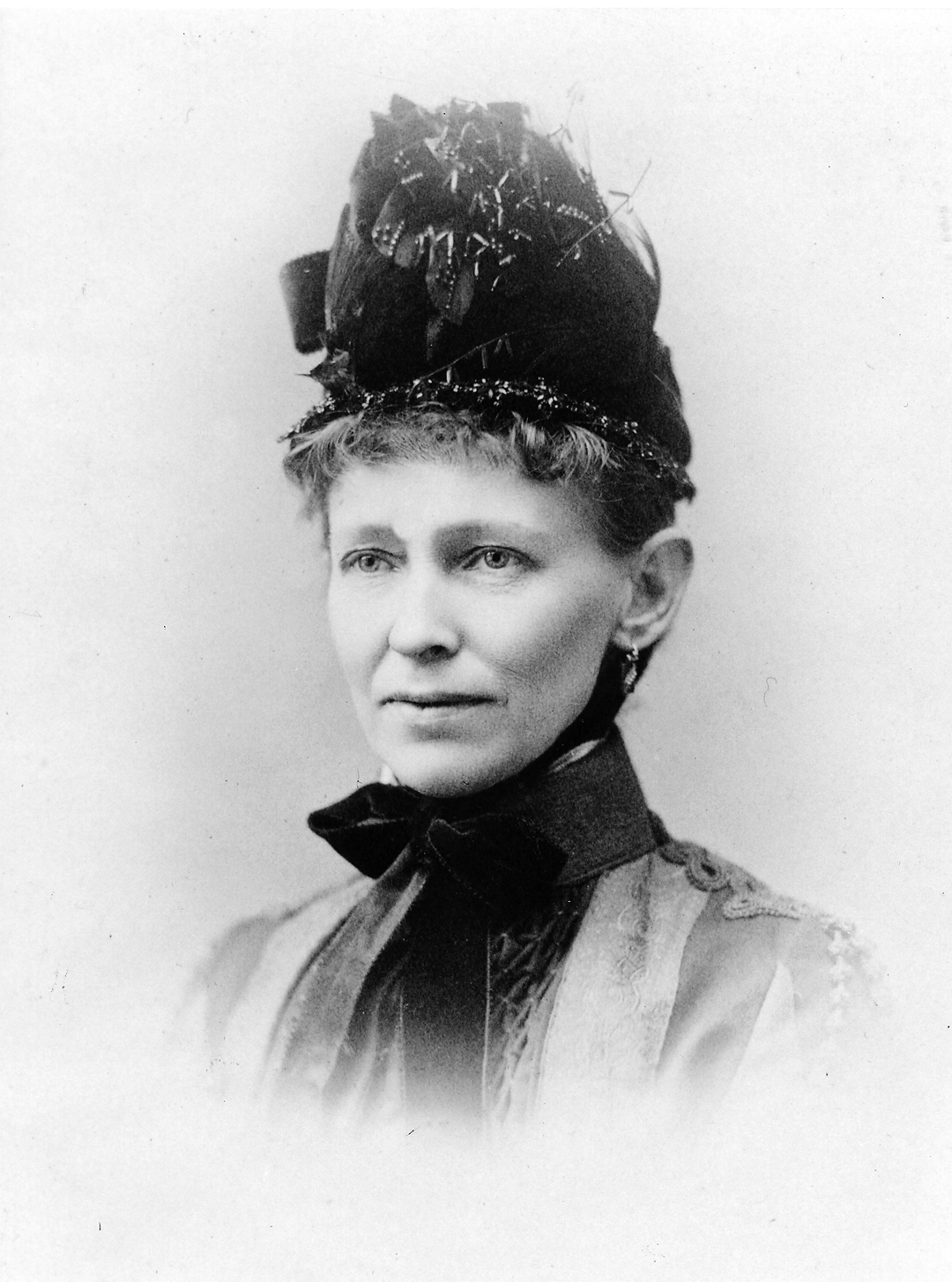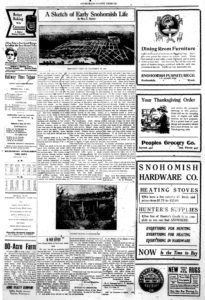A Sketch of Early Snohomish Life
By Mary Low Sinclair, published in the Snohomish County Tribune, November 24, 1911.
On the first day of May, 1865, a small, unfinished steamer, The Mary Woodruff, slowly made her way against the strong current of the river, having left Port Madison, Kitsap county, the day before, with the families and household goods of W. B Sinclair and I.C. Elles, who were removing to Cadyville, as it was then called. Mr. Sinclair had bought out Cady the December previous and started a small trading post. Ellis also began logging for the Puget Mill Co. at the same time, building his camp in the dense forest near where the E.C. Ferguson home now stands. As the steamer landed at the gravel bank near the foot of Maple street, a small clearing appeared in the other wise unbroken timber. The town consisted of a rough log house on the bank, in which supplies were stored. The store farther back was a 12×16 shack. The old building still standing at the corner of Maple and Commercial streets, without windows, doors or floor, in time was used for the store, with living rooms in the back. During forty-seven years the Sinclair house has stood, the roof never having been renewed.
The original home of E.C. Ferguson is still standing, having been remodeled and now belongs to M.J. McGuinness.
There was much to do, but the pioneers were hustlers and could turn their hands to anything–no specialists in those days. The women, young and hopeful, fearing neither danger no privation, soon began to make things look homelike. A large fire place assisted materially in clearing the door yard, in which later bloomed old-fashioned flowers–Sweet Williams, Marigolds and Hollyhocks. There was no time to be lonesome; the frogs sang cheerily in the near-by marshes; mosquitoes kept the people busy building smudges. Wild game was plentiful. The Indians brought venison, wild ducks, fish and clams. Also the ranchers from Snoqualmie prairie brought delicious hams and bacon of their own curing. For two years there was no regular steamer outside, and the only fruit obtainable was wild berries. But living was cheap and good, and not a butcher shop within forty miles. the Indian wives of the ranchers made sociable calls on their white neighbors, conversing in mingled Boston, Chinook and Siwash wawa (talk). One of the aristocracy, Mrs. Jenny, dressed in red cotton velvet, surprised the hostess by asking for patterns of the latest fashions in clothes. Julia also came, young and buxom, the third wife of Jack Pillchuck, with her first born, Haqueos, sitting on a basket of blackberries carried on her back. Occasionally wild Indians, Klikitats, insisted on coming in to see the white women and babies.
The storekeeper, while blazing a trail up Pillchuck to get the cattle into their winter forage of rushes, cut his foot severely, limped home and with second aid dressed and sewed up the wound. One morning a hurry call came. A man had taken poison by mistake, but a pot of strong coffee and a basket of eggs saved his life. The first burial was that of a drowned stranger, who was laid to rest under a large cedar tree. Mr. Ferguson read the English burial service, and on the home-made coffin rested a simple bunch of daisies among the evergreens. Could the elaborated floral offerings of today express more?

“A small clearing in otherwise unbroken timber.”
Photo attributed to E.M. Sammis, a New York photographer on his way to Snoqualmie Falls in 1865.
E.C. Ferguson’s Blue Eagle Saloon is on the left, Sinclair’s “shack” is on the right, and the figure in the foreground could be Woodbury Sinclair, Mary Low’s husband.
Some one said: “Write something funny.” Life was too serious, amid such surroundings to be comical. The spirit of the Indians, perhaps, who paddled their canoes silently in the dusky shadows, and spoke in low tones, lest the Stick Siwashes (ghosts) came down and caught them. One Sunday two farmers with their native helpmates came to trade, bought $50 worth, and said it was time to go home, but those stubborn creatures sat on a log outside and would not move until an additional $10 shawl was given each. About dark Frenchy and Jake surrendered. It was dangerous to have words with the cook in those days, for after doing so a man came home to dinner and found his hanging to the limb of a crabapple tree. As the country began to settle up the town began to take on airs. The front of one house was painted. A man in a white shirt astonished the natives, as did the first horseman passing through. Finally an ox cart, with great wooden wheels was heard, as well as seen on the street. Clark Ferguson was the fortunate owner.
E.C. Ferguson found a bride in Olympia. Samuel Howe met his promised wife in Victoria. She left her English home and braved a five thousand mile sea voyage via Cape Horn to join the lover of her youth in making a new home in the wilderness. E.D. Smith, of Lowell, married Miss Margaret Getchell in San Francisco. She came out from Maine across the isthmus. W.M. Ward and wife, the Blackmans, J.N. Low and many other important families arrived. Our pleasures were few and simple, but none the less enjoyed
On Sunday afternoons, gathered in the first school house, we would repeat the Lord’s Prayer. Mr. Ward led the singing, which was followed by an original address by some one in the audience on moral, religious or philosophic topics. Varied social diversions at the homes promoted good will and friendship.
The early settlers will all soon have crossed the river, and have been forgotten, but while life lasts the associations and friendships of those early times will never be forgotten.
. . . .
NOTES: Photograph of Mary Low Sinclair was taken by the LaRoche Studio in Seattle, dated 1905, courtesy University Libraries Special Collection #26773.
Read more about Mary Low Sinclair on HistoryLink.org.


